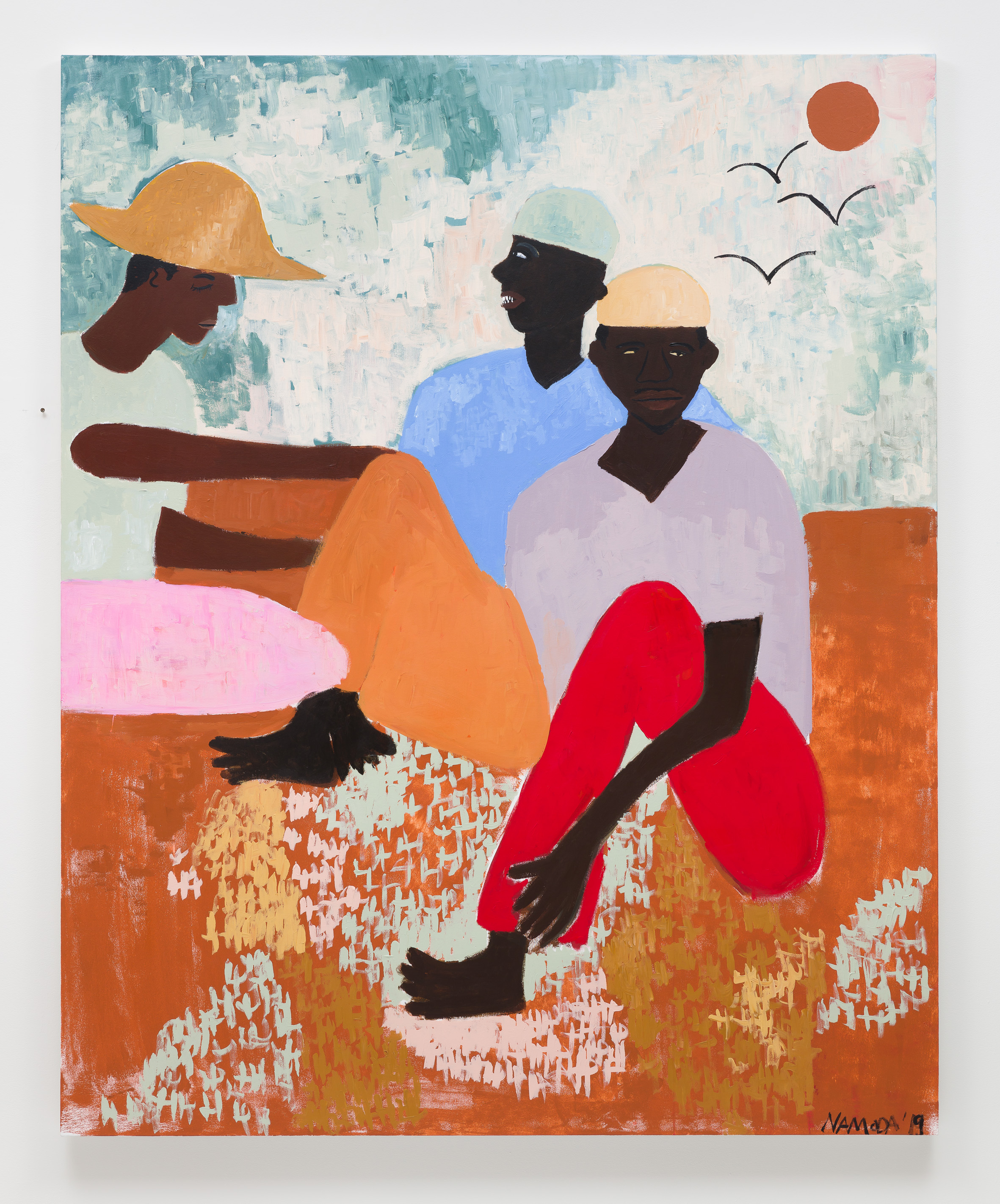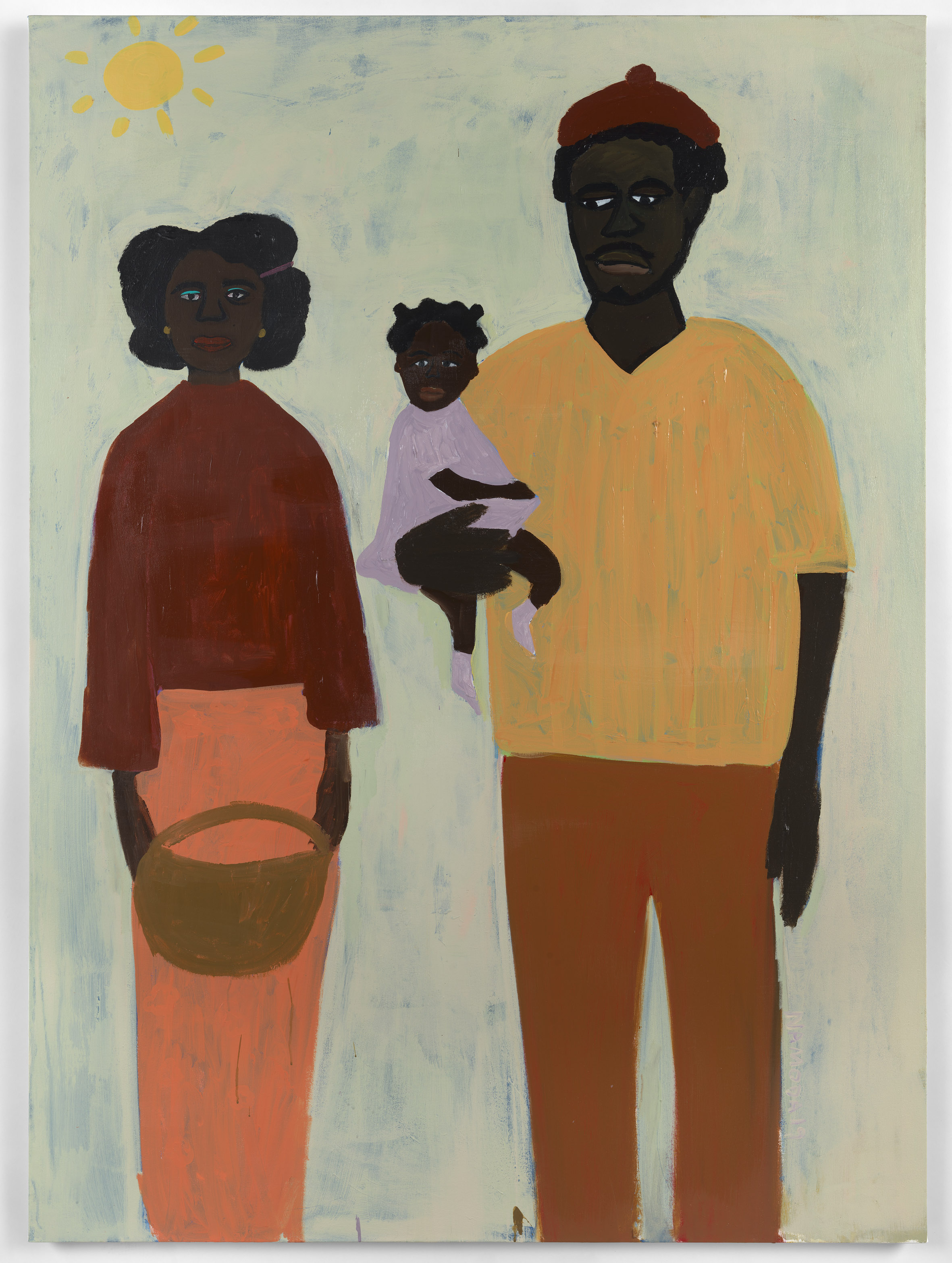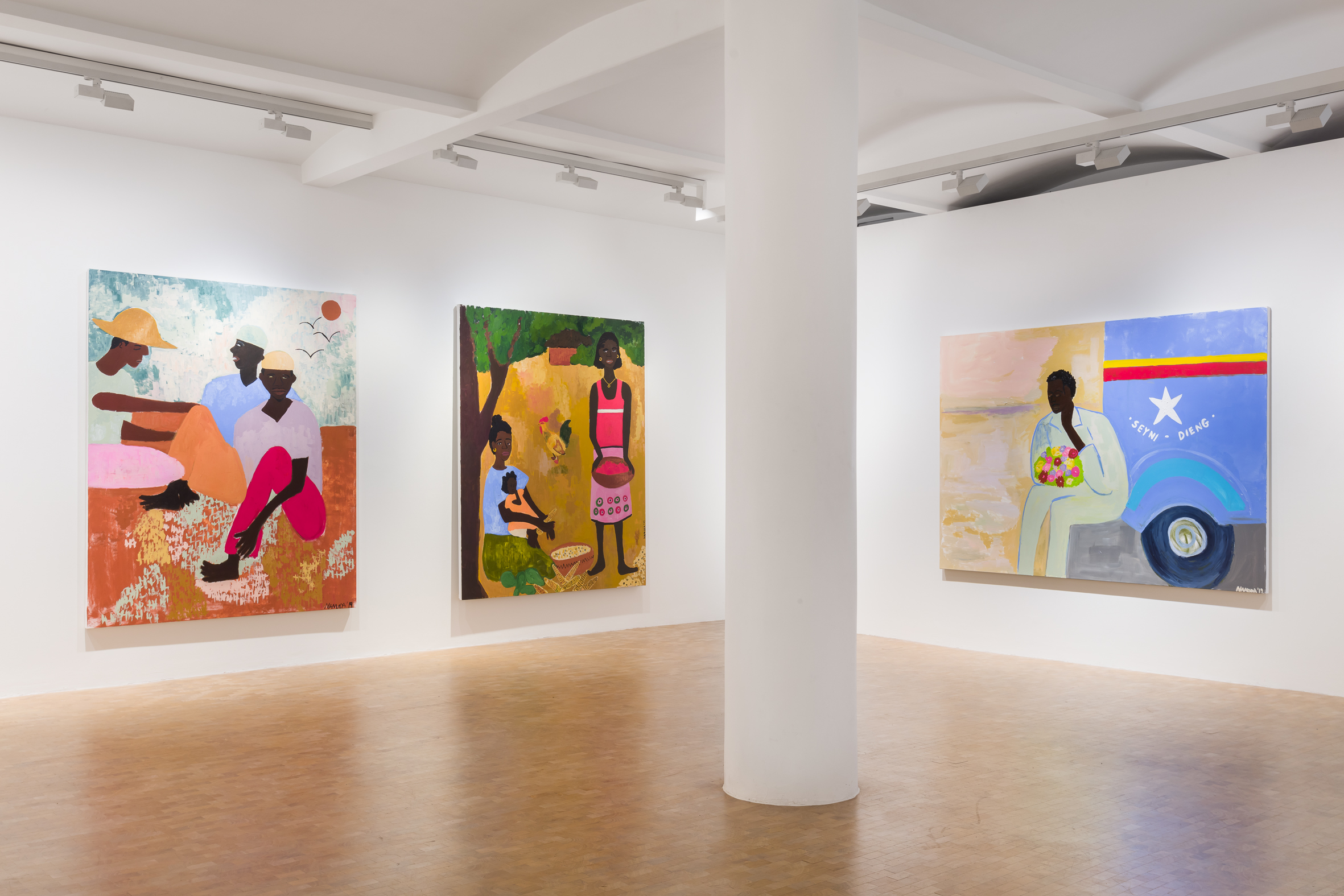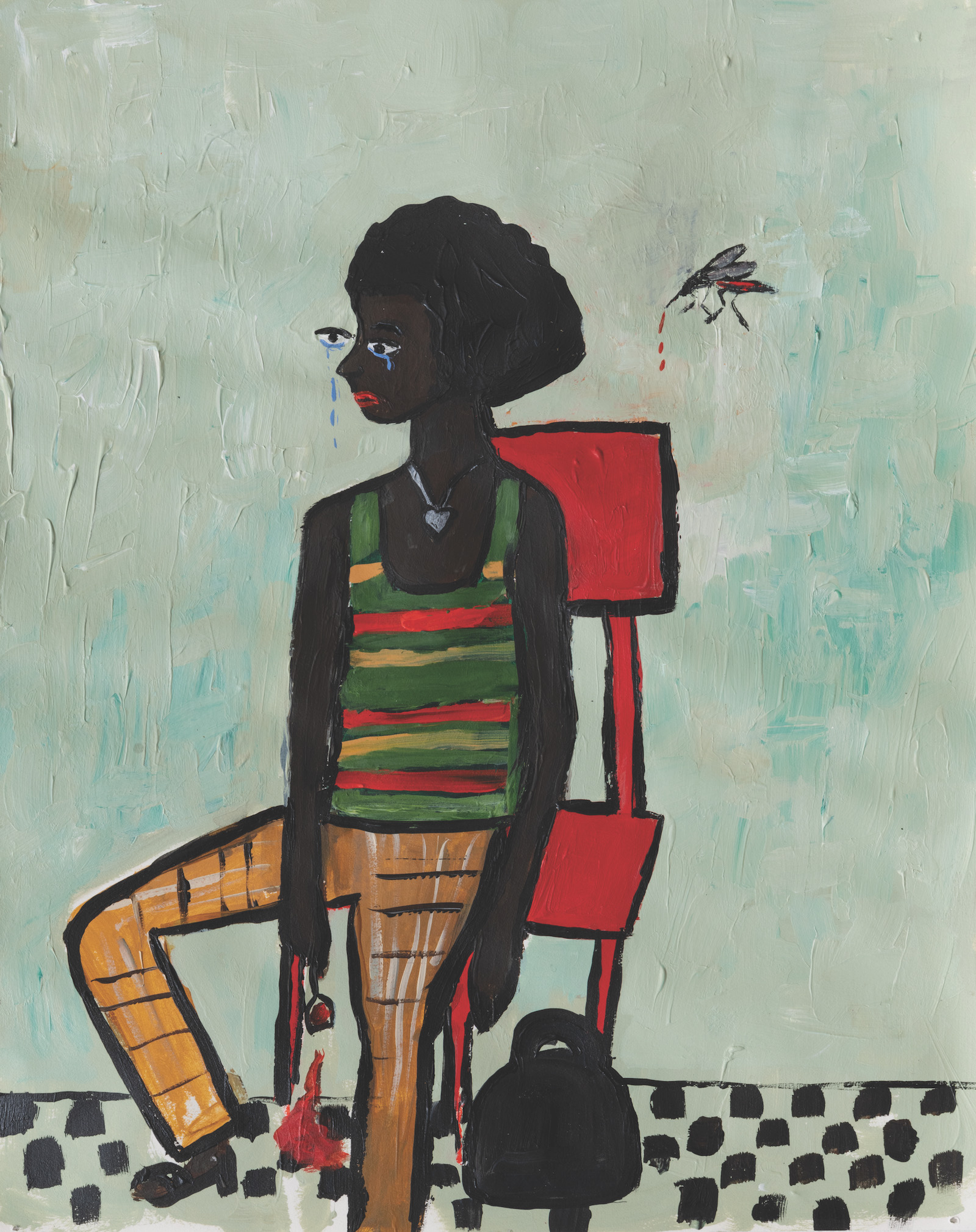
Maputo—Mozambique’s capital and largest city—is the subject of Cassi Namoda‘s first solo exhibition in Europe, which recently opened at Pippy Houldsworth Gallery in London. The young painter, who is now based in the US, was in attendance as the show was revealed to the public, giving a brief performance pouring tea harvested from the mountains of the northern region of Gurúè, where her grandfather is from, using an original colonial tea set that now sits on a plinth among her paintings. While Gurúè—as Namoda explains—has its own significance in her work, it’s the people, terrains and colours of her birthplace, Maputo, that take centre stage.
“I think that wanting to be an artist is an innate thing: it comes through you”
Namoda paints scenes that are partly-fictional, with soft, gestural brushstrokes: people dance and drink, two women prepare food, a young lover in a white suit waits with a bouquet of flowers on a bus, a wedding takes place on the sands of Maputo Bay. The scenes are all drawn together through the East African proverb the show takes its title from: Little Is Enough for Those in Love. These amorous figures are loose representations of love, family and social life, archetypes more than individuals, suggesting Namoda is interested in the lyrical possibilities of paint and open-ended narratives inspired by a long past and a visionary present. This quality is perhaps inspired by her reading of the late Kenyan Christian theologian John Mbiti who died last year, who suggested that any idea of the future is absent in traditional African thought.

From what I’ve read about your background, you seem to have been exposed to lots of different cultures and landscapes. How much has that shaped the way you make art?
I started painting at a young age. My first paintings were observational works from my trips to see the wildlife in Kenya with my family. I think that wanting to be an artist is an innate thing: it comes through you and it’s up to you to choose a path in life that encompasses it. I’ve lived in many places across the world: Kenya, Indonesia, Haiti, Benin, Angola, Mozambique, New York, the Dominican Republic, Morocco… the list goes on. I don’t think that the locations I’ve lived in are the most important thing though. If you are attuned to life, then anything can become a source of inspiration or a story to tell. I like the idea of my work being about storytelling. It could be in many other mediums. But I am in love with paint. It manages to express what I am trying and willing to convey and that constantly excites me.

Can you tell me more how you developed the narrative aspect to your work, particularly as your characters are drawn partly from memory and imagination?
I started painting with watercolours and I think the dream-like, lucid aesthetic that can come from watercolour is such an important foundation for my painting today. The figures all come from my love and enthusiasm for storytelling. I enjoy dovetailing different concepts in literature—mainly Lusophone stories, historical and familial narratives, memories and the photographic works of Ricardo Rangel. All of these contribute to building my characters.

In the performance at the opening of your exhibition at Pippy Houldsworth Gallery, you referred to the tea-growing region your grandfather is from. Can you tell me more about why that location is important to you and how you came up with this performance, in relation to your paintings?
I made a painting for François Ghebaly Gallery in Los Angeles of a woman centred in the middle of the canvas holding a crimson cup towards her chest in an evocative manner, with two monkeys floating side by side. The background is the hills of the Gurúè region in Mozambique. This painting inspired the act of libation that I performed at Pippy Houldsworth Gallery. I realize most of these paintings come through me because of my ancestors’ connection to Gurúè. I decided to make a limited tea collection from the town. Through this, I am recognizing the birth of this terroir in my work.
“I wanted to keep my painting within the realm of the unorthodox”

This has been quite a moment for you as your special illustrated cover for Vogue Italia recently came out, and the response has been incredible, especially as it had a strong message about sustainability.
It was really just good timing and intuition about what it means to make a good cover. I feel very lucky I had the chance to be included in something so monumental. It took me a couple of trial runs before I came up with the final concept for the Vogue Italia cover. I eventually gravitated towards a very personal style, common to all of my work. I thought that would be in the spirit of this project where such a major global magazine was commissioning artists to design the covers—I wanted to keep my painting within the realm of the unorthodox. The image was a dovetail of past works, along with some guidelines from Ferdinando Verderi, the creative director of Vogue Italia: for example, the model’s outfit had to be Gucci. I like when a painting has many different stories though and I think this painting has multiple layers. Although it’s a fashion image, there’s an ecological dimension to it as well. The glass of wine on the verge of spilling, the weeping eyes and the mosquito dripping blood are all an inkling of a gloomy future—if we don’t change our ways.

You’ve recently moved to a big new studio. What’s it like and how much of a difference is that going to make to you in your practice?
When it comes to my future, the keyword is expansion—that feels crucial for me. I am traveling to Lamu in Kenya soon and there I am planning to make some observational paintings and also do some woodworking with the help of a future collaborator, Moran Munyuthe, who founded the furniture company Saba Studios. I am hoping that when I return to my new studio after the trip, I will experience a cathartic release of everything I’ve learned. My next studio will be the biggest and grandest yet. I have dreams of it encompassing a ceramics workshop, a library, an office, a sewing parlour… all this is possible. With the constant changes in my life, I never really feel “stuck” creatively; I think that would be very hard for me.
Cassi Namoda, Little Is Enough for Those in Love
Until 4 March at Pippy Houldsworth Gallery, London
VISIT WEBSITE





